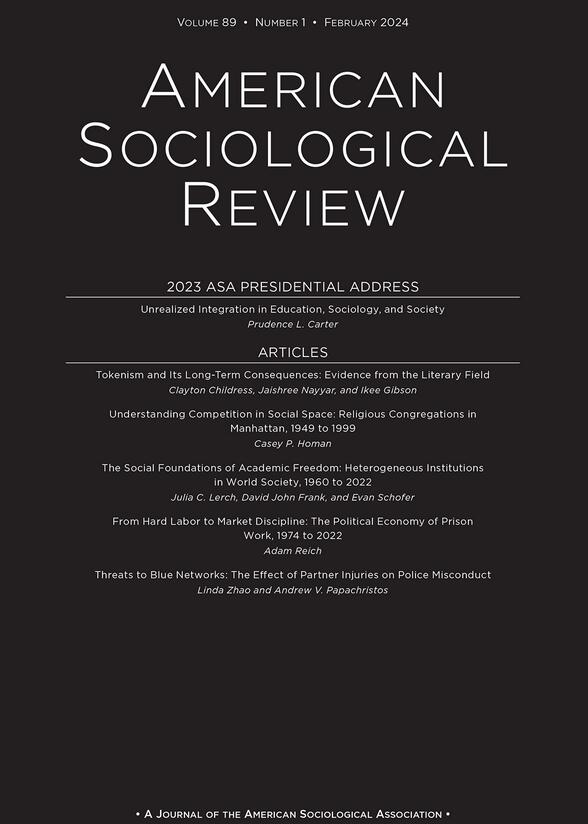Racial Discrimination in Housing: How Landlords Use Algorithms and Home Visits to Screen Tenants
IF 6.2
1区 社会学
Q1 SOCIOLOGY
引用次数: 41
Abstract
An extensive literature documents racial discrimination in housing, focusing on its prevalence and effect on non-White populations. This article studies how such discrimination operates, and the intermediaries who engage in it: landlords. A fundamental assumption of racial discrimination research is that gatekeepers such as landlords are confronted with a racially heterogeneous applicant pool. The reality of urban housing markets, however, is that historical patterns of residential segregation intersect with other structural barriers to drive selection into the applicant pool, such that landlords are more often selecting between same-race applicants. Using interviews and observations with 157 landlords in four cities, we ask: how do landlords construct their tenants’ race within racially segmented housing markets, and how does this factor into their screening processes? We find that landlords distinguish between tenants based on the degree to which their behavior conforms to insidious cultural narratives at the intersection of race, gender, and class. Landlords with large portfolios rely on screening algorithms, whereas mom-and-pop landlords make decisions based on informal mechanisms such as “gut feelings,” home visits, and the presentation of children. Landlords may put aside certain racial prejudices when they have the right financial incentives, but only when the tenant also defies stereotypes. In this way, landlords’ intersectional construction of race—even within a predominantly Black or Latino tenant pool—limits residential options for low-income, subsidized tenants of color, burdening their search process. These findings have implications for how we understand racial discrimination within racially homogenous social spheres. Examining landlords’ screening practices offers insight into the role housing plays in how racism continues to shape life outcomes—both explicitly through overt racial bias, and increasingly more covertly, through algorithmic automation and digital technologies.住房中的种族歧视:房东如何使用算法和家访来筛选租户
大量文献记录了住房中的种族歧视,重点关注其普遍性及其对非白人人口的影响。本文研究了这种歧视是如何运作的,以及参与歧视的中介机构:房东。种族歧视研究的一个基本假设是,房东等看门人面临着种族异质的申请人群体。然而,城市住房市场的现实是,历史上的居住隔离模式与其他结构性障碍相交叉,从而推动了申请人的选择,因此房东更经常在同一种族的申请人之间进行选择。通过对四个城市157名房东的采访和观察,我们问道:房东如何在种族划分的住房市场中构建租户的种族,以及这是如何影响他们的筛选过程的?我们发现,房东根据租户的行为在种族、性别和阶级交叉点上符合阴险文化叙事的程度来区分租户。拥有大量投资组合的房东依赖于筛选算法,而夫妻房东则根据“直觉”、家访和孩子的介绍等非正式机制做出决定。当房东有适当的经济激励时,他们可能会抛开某些种族偏见,但前提是租户也要打破刻板印象。这样,房东对种族的交叉构建——即使是在以黑人或拉丁裔为主的租户群体中——也限制了低收入、有补贴的有色人种租户的居住选择,加重了他们的搜索过程。这些发现对我们如何理解种族同质的社会领域中的种族歧视具有启示意义。通过检查房东的筛选做法,我们可以深入了解住房在种族主义如何继续影响生活结果中所起的作用——既有明显的种族偏见,也有越来越隐蔽的算法自动化和数字技术。
本文章由计算机程序翻译,如有差异,请以英文原文为准。
求助全文
约1分钟内获得全文
求助全文
来源期刊

American Sociological Review
SOCIOLOGY-
CiteScore
13.30
自引率
3.30%
发文量
35
期刊介绍:
The American Sociological Association (ASA) is a non-profit membership association established in 1905. Its mission is to advance sociology as a scientific discipline and profession that serves the public good. ASA is comprised of approximately 12,000 members including faculty members, researchers, practitioners, and students in the field of sociology. Roughly 20% of the members work in government, business, or non-profit organizations.
One of ASA's primary endeavors is the publication and dissemination of important sociological research. To this end, they founded the American Sociological Review (ASR) in 1936. ASR is the flagship journal of the association and publishes original works that are of general interest and contribute to the advancement of sociology. The journal seeks to publish new theoretical developments, research results that enhance our understanding of fundamental social processes, and significant methodological innovations. ASR welcomes submissions from all areas of sociology, placing an emphasis on exceptional quality.
Aside from ASR, ASA also publishes 14 professional journals and magazines. Additionally, they organize an annual meeting that attracts over 6,000 participants. ASA's membership consists of scholars, professionals, and students dedicated to the study and application of sociology in various domains of society.
 求助内容:
求助内容: 应助结果提醒方式:
应助结果提醒方式:


